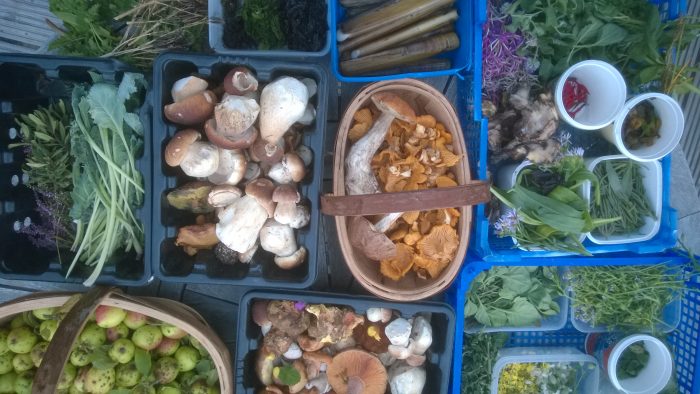Foraging as a Springboard for Creativity
“No place for her in the slow, terrible armies of the cautious. She ran ahead where there were no paths.”
– Dorothy Parker on Isadora Duncan.
Every forage is a journey of discovery and creativity. There is always an element of the unexpected. Even on home turf.
Yesterday, for example, I popped out to pick some water pepper from a riverbank 15 minutes walk from our house. I pop out to forage like many people pop out to the shops. And just like shoppers, I tend to encounter “mission creep”.
I didn’t come back with the water pepper (which I had intended to use as an experimental spicy infusion in my sundowner – alas, its done for the season), but with a dozen or so other delights that kept me busy in the kitchen until midnight. Sloe and cloveroot ice cream, dandelion tonic, hogweed root gin, blewit risotto, pineapple weed shrub, ground ivy vinegar…it was a late night…
At the outset, I hadn’t the time, energy or inspiration to do any of this stuff. But wild ingredients are inspiring like nothing you can buy. They fire the imagination with their vibrancy, freshness and unique flavours. By the time you get them home, you have already invested time and care in gathering – so it would be criminal to let them fester. They demand loving treatment.

A Forager’s Palate – What creativity will it inspire?
Moreover, coming home with what nature, rather than a marketing campaign, has thrown at you stimulates the imagination. Experimentation becomes the norm. Safe old dishes start to look… safe and old. Unshackled from the crutch of recipes (which, lets face it, are often the imposition of someone else’s taste/ego/business plan), you develop a “feel” for what works. What works chemically, seasonally, geographically, gastronomically, and most importantly, what works for you.
Don’t get me wrong, there is an important place for classic techniques, combinations, proportions and recipes, but these should be the building blocks of cookery and mixology, not the end result. Rather than decide what you want to make, acquire the prescribed ingredients and prepare a meal or drink, how much more satisfying to respond to what is fresh and of-the-moment.
For meal this might be as simple as replacing a store-bought staple with something fresh and local, or as complex as making reedmace rhizomes into flour. But more often it is the pleasure of compiling spring greens into a surprising salad of novel textures and flavours contrasts, or exploring what a curry made from local wild spices will taste like.
For drinks it might mean throwing off the crutch of “citrus addiction” and exploring indigenous acidifiers like crab apples, sorrel and sloes (apologies to overseas readers, for whom citrus is the natural local acidifier!). Or putting aside those ‘bottled airmile bitters’ and exploring the wealth of aromatic bitters in, say, the carrot family.
Desert the slow, terrible armies of the cautious.
Run ahead.
___________________________________________
This post is dedicated to my friend, creative wild food inspiration, and all-round good guy, Fergus Drennan, a pioneer and constant source of (often unaccredited) ideas and inspiration to the whole foraging community.
2 Comments
Love your blog (found it via the Canadian Gather Victoria I think!), it’s really nice to read one written in Britain, as it were; most of the foraging blogs I’ve read have been the other side of the Pond, as it were. I’ve had a browse through and I really like the way you’ve set things out, it’s so easy to find everything. And your photos are great! I miss Scotland sometimes (raised on Skye for 13 years, I can still speak Gaelic and ceilidh dance!) with its abundance of rowan trees. There’s none here in the woods in this part of France, but at least there’s plenty of chestnuts!
I’ve been bookmarking your recipes with notes to myself for a fantasy story that I’m working on (getting the background sorted out) which is essentially centred around a “kitchen-witch” as people call her (no magic involved, just a reputation and a half) who spends a lot of her time teaching “difficult” girls and taking them out foraging and setting them jobs to do like pound reedmace in the pestle and mortar into a flour (for example!) to teach them the value of good work. Thank you for putting these recipes up, especially the local spices one; that’s so useful! European “spices” could be seriously useful as a plot-point in the story when it comes to foreign trade and the mad taxes on spices…anyway. I’d say thank you again in Gaelic, only my spelling was always terrible! Cheers from my part of the South of France, Haute-Pyrenees.
Thanks for this Rhiannon – I’m so glad you find my website helpful. 🙂 Mark